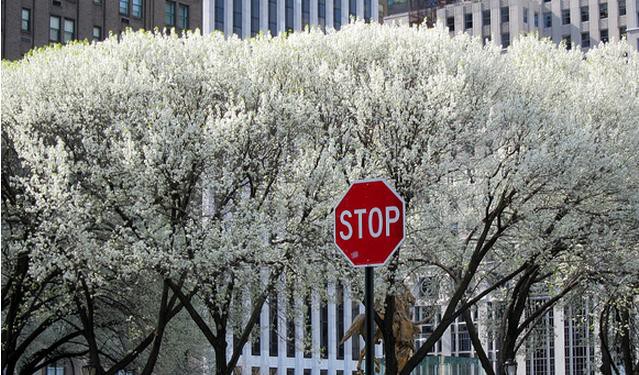Your Street Probably Smells Like Semen Right Now -- But It Might Not Next Spring
by Juliet Lapidos

On a mild April night some years ago, I walked past a college dorm in New Haven and smelled something I couldn’t place. It reminded me vaguely of swimming pools. Was it chlorine? I sniffed again, more deeply than before. Suddenly I knew exactly what it was and hurried away, internally berating an unseen teenage boy. A few evenings later, in the same spot, I smelled it again. Filled with a sense of moral outrage I looked around, I looked up, and identified the culprit: A tree.
More precisely, a Callery Pear, or Pyrus calleryana, a deciduous tree that’s common throughout North America. It blossoms in early spring and produces beautiful, five-petaled white flowers — that smell like semen.
Like when you learn a new word and then see and hear it everywhere, after making the connection between Callerys and the scent of semen I saw and smelled them everywhere. I said that Callerys are “common”: A preposterous understatement. In Manual of Woody Landscape Plants, which is for horticulturists what the DSM is for psychotherapists, Michael Dirr says that the Bradford Pear — a Callery cultivar — inhabits “almost every city and town to some degree or another” and warns that “the tree has reached epidemic proportions.” There’s one between my apartment and my favorite coffee shop in Brooklyn, and there’s probably one between your apartment and your favorite coffee shop. The last time New York’s Parks Department conducted a tree census, from 2005 to 2006, there were 63,600 Callery Pears, making it the third-most popular species in the city, after the London Planetree and the Norway Maple.
The Callery’s aroma is an open secret. Three years ago The Frisky published an article titled “A Tree That Smells Like…Well…Um…,” which directed me to a Yahoo! Answers thread on the topic, and to the Urban Dictionary entry “Semen Tree.”
But in the professional literature, euphemisms abound. Dirr calls the Bradford “malodorous” and leaves it at that. (By contrast, here’s how he describes the Bradford’s fall coloration: “spectacular reddish purple, others yellow to red reminding of a persimmon orange.”)
The way I see it, there’s weirdly little attention paid to the fact that, for a few weeks each year, there’s a good chance your street smells like semen. We just carry on as if that were normal.
The Callery’s not even the most-talked-about smelly tree, a distinction that certainly belongs to the vomit-perfumed Ginkgo. There’s even a New Yorker Talk of the Town about the Ginkgo’s stench — and the three media-savvy teenagers who formed an Anti-Gingko Tolerance Group. But the Callery? The New Yorker doesn’t care. There is no Anti-Callery Tolerance Group.
Despite the absence of grassroots agitating against the Callery, we may have reached peak semen-smell. As Dirr puts it, Bradfords tend to “develop rather tight crotches,” which makes them prone to splitting as they age. And while not every Callery cultivar splits easily — the Aristocrat and the Chanticleer fare better — they’re all borderline invasive, taking up shop in abandoned lots without human intervention. (And less urban ecosystems as well: A National Parks Service publication explains how to cut them down and apply herbicides to the stumps.) For these reasons — not because of their smell — they’re falling out of vogue with urban parks departments.
New York now plants just 20 or 30 Callerys per year, while literally thousands are lost to attrition (from storm damage and such). Jeremy Barrick, the deputy chief of forestry, horticulture and natural resources at the Parks Department, expects the Callery to lose its number 3 spot in the 2015 census. He anticipates a total Callery count of roughly 30,000 — a 50-percent decline from 2006.
That’s progress. But for the time being, you can tell it’s spring if you smell semen.
Juliet Lapidos is an editor at the New York Times. Photo by Bosc d’Anjou.
